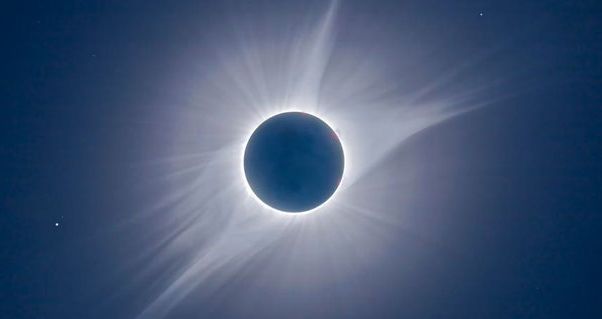
Start time for April 8 Yankees vs Marlins game changed due to solar eclipse concerns

Major League Baseball announced yesterday that, after reconsidering the challenges of playing through Monday’s solar eclipse, including potential in-game delays, MLB and the Yankees have rescheduled the start time of the Yankees-Marlins game on April 8 at Yankee Stadium from 2:05 p.m. to 6:05 p.m.
All Yankee Stadium gates will open to guests with valid tickets beginning at 3:00 p.m.
As previously scheduled, the first 15,000 guests in attendance will receive a Yankees Solar Eclipse T-Shirt presented by HubSpot.
The game will be broadcast on the YES Network.
According to the American Astronomical Society (AAS), the highly publicized and anticipated solar eclipse on April 8, 2024, will occur due to the Moon passing directly between Earth and the Sun as seen from North America. The new Moon will fully block the Sun’s bright face, turning day into deep twilight and revealing the magnificent solar corona, our star’s wispy outer atmosphere. Our natural satellite’s dark shadow, about 115 miles wide, will cross Mexico, sweep from Texas to Maine, and then darken parts of eastern Canada.

Tens of millions of people within the path will experience a total solar eclipse — at least the midday darkness, and a stunning view of the corona if skies are clear. Outside this narrow path, nearly everyone on the continent will get a chance to witness a partial solar eclipse, which is not nearly as awe-inspiring as a total one but still better than no eclipse at all.
From beginning to end, a solar eclipse lasts up to about three hours. For most of that time, the Moon slowly covers the Sun, then uncovers it; these are the eclipse’s beginning and ending partial phases. The real excitement comes in the middle, but only for those within the narrow path of the Moon’s dark shadow, and only for a few precious, fleeting minutes.
You can experience a total solar eclipse only if you’re within the path of totality, a narrow ribbon arcing thousands of miles across Earth’s curved surface. The path of totality is the track of the dark shadow cast by the Moon as it moves in its orbit. Outside this path, no matter how close you are to it, you’ll only experience a partial solar eclipse. Some places along the path of totality are more likely than others to have clear skies, but anywhere within the path is better than anywhere outside the path. A total solar eclipse experienced under cloudy skies is more exciting than a partial solar eclipse seen under clear skies.
“If you can get yourself into the path of the Moon’s shadow for a total solar eclipse, it’s definitely worth the effort,” says Rick Fienberg, Project Manager of the American Astronomical Society (AAS) Solar Eclipse Task Force and Senior Contributing Editor of Sky & Telescope. “A 99% partial solar eclipse doesn’t get you 99% of the experience of a total solar eclipse — the last 1% is the difference between night and day. As the Moon blots out the thinning arc of the bright Sun in the final minute before totality, daylight fades by hundreds of times. And the solar corona surrounding the Moon’s velvety black silhouette is one of the most glorious sights in all of nature!”
During a total solar eclipse you’ll experience many other noteworthy phenomena, including a drop in air temperature, changes in wind speed and direction, bright planets and stars shining in deep twilight, ruby-red solar prominences (eruptions of hot gas protruding beyond the limb, or edge, of the Sun’s hidden disk), pastel sunrise/sunset colors around the horizon, and animals, birds, insects, and perhaps even plants behaving as if the Sun has set. Another total solar eclipse won’t cross the U.S. until August 12, 2045, so this April’s event is your best chance to catch totality here for a generation.
Eye Safety Is Paramount
The totally eclipsed Sun is about as bright as a full Moon in the sky and is just as safe to look at directly without eye protection, even through binoculars or a telescope. But during the partial phases, the Sun remains dangerously bright at all times and must never be looked at directly except through special-purpose “eclipse glasses” or handheld solar viewers that meet the requirements of the ISO 12312-2 international standard. The American Astronomical Society’s webpage on eye safety has valuable advice on where to get safe solar filters and on indirect viewing methods. During totality, you can and should remove your eclipse glasses or solar viewers — otherwise you won’t see anything at all!

Buy Special Solar Eclipse Glasses on Amazon
Eclipse glasses and handheld solar viewers are meant to be used only with your eyes. Never look at the Sun through an unfiltered camera, telescope, binoculars, or any other optical device while using your eclipse glasses or handheld solar viewer — the concentrated solar rays could damage the filter and enter your eyes, causing serious injury. Solar filters must be attached to the front of any telescope, binoculars, camera lens, or other optics.
–
(Source: MLB / AAS)
Posted by Richard Webster, Ace News Today
Follow Richard on Facebook, Twitter & Instagram






